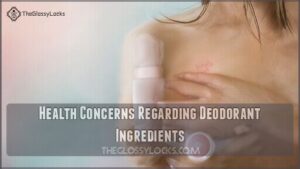This site is supported by our readers. We may earn a commission, at no cost to you, if you purchase through links.

The skin beneath your breasts is more sensitive than your underarms, making it prone to irritation from harsh chemicals found in regular antiperspirants.
If you’re wondering "is it safe to put deodorant under your breasts," the answer depends on your skin type and the product you choose.
Aluminum-based antiperspirants can cause contact dermatitis or rashes in this delicate area.
Your best bet is choosing gentle, aluminum-free formulas designed for sensitive skin.
Always patch test first—nobody wants to deal with angry, irritated skin when you’re just trying to stay fresh and comfortable throughout the day.
Table Of Contents
- Key Takeaways
- Is It Safe to Put Deodorant Under Your Breasts?
- Is Deodorant Safe for Under Breasts?
- Potential Risks of Using Deodorant Under Breasts
- Health Concerns Regarding Deodorant Ingredients
- Safe Alternatives to Deodorant for Underboob Sweat
- Impact of Deodorant on Breast Health
- Managing Underboob Sweat Without Deodorant
- Creating a Sweat Management Routine
- Seeking Medical Advice for Underboob Sweat
- Lifestyle Changes to Reduce Underboob Sweat
- Frequently Asked Questions (FAQs)
- Can I use deodorant under my breasts?
- Should you use deodorant if you have underboob sweat?
- What is a good deodorant for underboobs?
- Can you use deodorant under the armpits?
- Should you use aluminum-free deodorant under your breasts?
- Is applying deodorant all over your body safe?
- Can deodorant be used under breasts?
- Is it safe to put deodorant on your pubic area?
- What powder is safe to use under breasts?
- Is it OK to put deodorant on your chest?
- Conclusion
Key Takeaways
- You can use deodorant under your breasts, but you’ll need to choose gentle, aluminum-free formulas designed for sensitive skin to avoid irritation and contact dermatitis.
- You should always patch test new products first since the skin beneath your breasts is more delicate than your underarms and can react poorly to harsh chemicals found in regular antiperspirants.
- You don’t have to rely solely on deodorant—safe alternatives like talc-free powders, moisture-wicking bras, and anti-chafing gels can effectively manage underboob sweat without potential risks.
- You shouldn’t ignore persistent issues like rashes or infections—consult a healthcare provider if home remedies aren’t working, as they can recommend prescription treatments or identify underlying causes.
Is It Safe to Put Deodorant Under Your Breasts?
The question of deodorant under breasts sparks legitimate safety concerns.
Most dermatologists agree that topical antiperspirants are generally safe for under-breast use, but product selection matters enormously. Deodorant ingredients like aluminum compounds aren’t proven carcinogenic despite persistent rumors.
Choose gentle, alcohol-free formulas—your delicate breast skin deserves better than harsh aluminum compounds and questionable chemicals.
However, skin sensitivity varies dramatically between individuals.
Expert opinions emphasize choosing gentle, alcohol-free formulas with moisturizing properties. Proper application techniques include patch testing first.
Safe deodorant use requires selecting cream or soft solid formulations over gels. For those with sensitivities, fragrance-free options can help minimize irritation.
This breast health advice guarantees effective breast skin care without irritation.
Is Deodorant Safe for Under Breasts?
Most women can safely use deodorant under their breasts, but it’s not a one-size-fits-all solution.
Regular deodorants and antiperspirants work well for underarm areas, but breast skin requires more thoughtful consideration. Your delicate breast skin deserves gentler treatment than standard aluminum-based products might provide.
While studies have shown no direct link between deodorant and breast cancer, some individuals may still have concerns.
When considering breast deodorant safety, keep these key factors in mind:
- Deodorant Ingredients – Choose aluminum-free formulas to minimize potential irritation
- Product Selection – Opt for gentle, hypoallergenic options designed for sensitive areas
- Patch Testing – Always test new products on a small skin area first
- Application Techniques – Apply sparingly to clean, completely dry skin
Safe deodorant use under breasts means prioritizing breast health advice over convenience.
While whole-body deodorants exist specifically for areas like underboob regions, breast skin care requires products that won’t clog pores or cause contact dermatitis in this moisture-prone area.
Potential Risks of Using Deodorant Under Breasts
Some studies suggest troubling connections between deodorant use and breast health concerns.
While dermatologists generally consider topical antiperspirants safe, you should understand the potential risks:
- Aluminum Concerns: Research indicates possible correlations between aluminum compounds and increased breast cancer risk, particularly with frequent use
- Skin Irritation: The delicate underboob area can develop contact dermatitis from deodorant chemicals
- Parabens Exposure: These preservatives in many products may pose unknown long-term health effects
Limited research exists specifically on under-breast deodorant application, leaving safety questions unanswered.
However, current research indicates no established link between antiperspirants and breast cancer.
Health Concerns Regarding Deodorant Ingredients
Understanding what’s inside your deodorant matters more than you think.
Aluminum absorption through breast skin raises breast cancer concerns, though research remains inconclusive. Paraben risks include hormonal disruption and fertility issues.
Fragrance allergens can trigger reactions on sensitive underboob skin. Talc exposure brings potential carcinogenic effects, while triclosan dangers affect your body’s natural balance.
If you have sensitive skin, these ingredients become even more problematic. Consider aluminum-free deodorant or natural deodorant options to minimize exposure to these questionable chemicals.
For a gentler approach, consider incorporating shea butter effects to soothe irritation.
Safe Alternatives to Deodorant for Underboob Sweat
Several antiperspirant alternatives can keep you comfortable without traditional deodorants. Talc-free powders absorb moisture effectively, while bra liners create a protective barrier against sweat. Moisture-wicking fabrics help your skin breathe naturally.
Consider these natural deodorant options:
- Aluminum-free deodorant with gentle ingredients
- Natural remedies like cornstarch-based powders
- Moisture-wicking bras that pull sweat away from skin
- Anti-chafing gels that prevent friction and heat buildup
These solutions offer peace of mind while managing underboob sweat effectively. Many users find relief using gentle, hypoallergenic deodorants.
Impact of Deodorant on Breast Health
Most experts agree there’s no strong evidence linking deodorant use to breast cancer, despite ongoing aluminum concerns.
The National Cancer Institute confirms no clear relationship exists between antiperspirants and cancer risk.
However, deodorant carcinogens remain a topic of debate, with some studies showing mixed results.
Skin irritation poses a more immediate concern than cancer risk.
Your delicate underboob area may react poorly to harsh ingredients, causing redness or breakouts.
For peace of mind, consider aluminumfree deodorant options that prioritize product safety while maintaining effective breast hygiene.
For those with sensitivities, consider gentle, hypoallergenic deodorants to avoid irritation.
Managing Underboob Sweat Without Deodorant
You don’t have to depend on deodorant for boob sweat prevention.
Natural absorbents like talcfree powder or cornstarch work brilliantly, soaking up moisture while reducing friction.
Your clothing choices matter too – moisture wicking bras and loose cotton tops promote airflow around sensitive areas.
Home remedies can be surprisingly effective.
Anti-chafing gels create protective barriers where skin meets skin.
Bra liners absorb sweat before it becomes problematic.
Some women find under breast hygiene improves with gentle cleansing wipes throughout the day.
Incorporating omega-3 fatty acids can also help strengthen the skin barrier.
Dietary impact shouldn’t be overlooked either.
Spicy foods and caffeine can trigger more sweating.
Hygiene practices like showering after workouts prevent bacteria buildup.
For severe cases, medical treatments like Botox injections offer long-term relief when simple solutions aren’t enough.
Creating a Sweat Management Routine
Building a solid sweat management routine doesn’t happen overnight, but it’s worth the effort. Start with daily cleansing using gentle, fragrance-free soap to remove bacteria and sweat buildup. Pat the area completely dry before moving to the next step.
Good hygiene starts with the basics – clean, dry skin sets the foundation for everything else.
For product application, choose your weapons wisely. Apply talc-free powder or cornstarch after your morning shower, focusing on skin folds where moisture loves to hide. If you’re using deodorant for under breast hygiene, stick with aluminum-free options designed for sensitive skin. Consider incorporating lightweight, non-comedogenic formulas to prevent clogged pores.
Your clothing choices make a huge difference in boob sweat prevention. Swap padded bras for breathable cotton or moisture-wicking materials. Loose-fitting tops help air circulate, keeping you cooler throughout the day.
Don’t forget hydration habits – drinking plenty of water helps regulate your body temperature. Make routine adjustments based on your activity level and the weather. Effective breast sweat management requires consistency, not perfection.
Seeking Medical Advice for Underboob Sweat
Your sweat management routine mightn’t always cut it.
When to Consult a healthcare provider? If you’re dealing with persistent under breast rash, skin irritation, or suspected yeast infection despite trying home remedies.
Don’t feel embarrassed—doctors handle these issues daily. A dermatologist can run Diagnostic Tests to identify underlying causes and recommend prescription treatments.
Specialist Options include topical medications like Qbrexza or even Surgical Considerations for severe cases. Treatment Side-Effects vary, but professional guidance guarantees you get the right solution for your specific situation.
For redness and irritation, consider a gentle skincare routine.
Lifestyle Changes to Reduce Underboob Sweat
Beyond medical interventions, simple lifestyle changes can dramatically reduce breast sweat and improve your daily comfort. Your clothing choices make the biggest difference – swap tight synthetic fabrics for breathable cotton or moisture-wicking materials that let your skin breathe.
Loose-fitting tops prevent that sticky feeling while dark colors hide any sweat marks. Dietary adjustments also play a key role in managing perspiration. Spicy foods and caffeine can trigger excessive sweating, so consider moderating these triggers.
Hydration importance can’t be overstated – drinking plenty of water helps regulate your body temperature naturally. To further protect your skin, consider daily sunscreen application to shield from environmental factors.
Here’s your action plan for better hygiene and comfort:
- Choose wireless bras with mesh panels for maximum airflow
- Maintain healthy weight management to reduce skin-to-skin contact
- Monitor your activity level during hot weather
- Apply deodorant preventively, not just reactively
These lifestyle changes work together to prevent chafing and keep you feeling fresh all day, which is crucial for your overall daily comfort and skin health.
Frequently Asked Questions (FAQs)
Can I use deodorant under my breasts?
Yes, you can safely use deodorant under your breasts.
Most deodorants and antiperspirants are safe for this area.
Choose gentle, alcohol-free formulas and perform a patch test first to avoid irritation.
Should you use deodorant if you have underboob sweat?
Are you tired of that sticky, uncomfortable feeling?
Absolutely use deodorant for underboob sweat! It’s safe and effective.
Choose spray formulas for easy application, or try aluminum-free options if you have sensitive skin.
What is a good deodorant for underboobs?
Choose gentle, aluminum-free spray deodorants for easier application under your breasts.
Clinical-strength options with 20% aluminum chloride work well for heavy sweating.
Avoid gels; opt for cream or soft solid formulas that won’t irritate sensitive skin.
Can you use deodorant under the armpits?
Well, that’s like asking if water’s wet! Of course you can use deodorant under your armpits—that’s literally what it’s designed for. Your underarms are the classic, tried-and-true deodorant zone.
Should you use aluminum-free deodorant under your breasts?
Aluminum-free deodorant offers peace of mind if you’re concerned about potential health risks. While regular antiperspirants are generally safe, gentle, aluminum-free options work well for managing underboob sweat without worry.
Is applying deodorant all over your body safe?
Like spreading sunscreen evenly, applying deodorant all over your body is generally safe.
Most products work fine on various skin areas, but avoid sensitive zones like intimate areas and always patch-test first.
Can deodorant be used under breasts?
Yes, you can safely use deodorant under your breasts. Most deodorants and antiperspirants work well there, but choose gentle, alcohol-free formulas to avoid irritating sensitive skin in that area.
Is it safe to put deodorant on your pubic area?
Most deodorants aren’t designed for your pubic area’s sensitive skin and can cause irritation, rashes, or allergic reactions.
You’re better off using products specifically formulated for intimate areas or consulting your doctor first, to avoid allergic reactions.
What powder is safe to use under breasts?
Choosing the wrong powder could spell disaster for your delicate skin.
Talc-free baby powder works best under your breasts, absorbing moisture without respiratory risks.
You’ll want cornstarch-based options that keep you dry and comfortable, and using the right powder is crucial to avoid disaster for your skin.
Is it OK to put deodorant on your chest?
Applying deodorant on your chest is generally safe, but avoid the nipple area and intimate zones. Choose gentle, alcohol-free formulas to prevent irritation on delicate skin, and always patch-test first.
Conclusion
Picture yourself confidently managing your day without worrying about underboob discomfort or irritation.
Now you know the answer to "is it safe to put deodorant under your breasts"—it depends on choosing the right product for your skin type.
Gentle, aluminum-free formulas work best for this sensitive area.
Remember to patch test first, consider safer alternatives like cornstarch or specialized powders, and don’t hesitate to consult your doctor if you experience persistent issues or unusual symptoms.
- https://nymag.com/strategist/article/how-to-deal-with-underboob-sweat.html
- https://health.clevelandclinic.org/boob-sweat
- https://www.justanswer.com/health/70vbb-ok-spray-deodorant-use-roll-breast.html
- https://www.healthline.com/health/womens-health/boob-sweat
- https://mykaoshop.com/blogs/ban/what-can-i-do-for-sweating-under-my-boobs?srsltid=AfmBOooSXEOgoCzPXzRm7K-uKRdvcShJLjHhXI4oHLYgxLp9TePznpeJ










